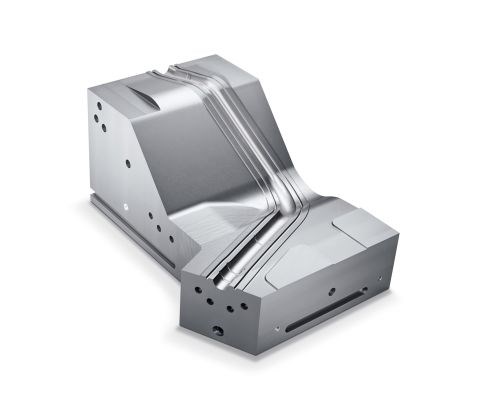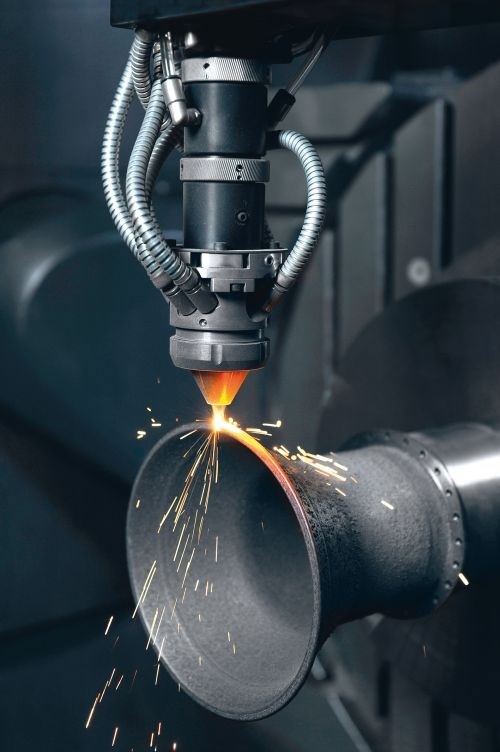DMG MORI Unveils 8 New Machines
Larger work envelopes, enhanced cooling capability and improved energy efficiency are among the features the new models have in common.
Share
Read Next

Photo courtesy of DMG Mori Seiki.
The part shown above, a tubular mold with a surface finish of Ra 0.35, is just one example of the sort of work DMG MORI had in mind when it designed its fourth-generation Duoblock five-axis, universal machining centers. These machines, the DMC 80 U and DMC 80 FD, were among eight new models unveiled to the world for the first time at the company's February open house in Pfronten, Germany. While the company touts the rigidity, precision and speed of all the new machines, some of the traits they share in common struck me as a bit different (and perhaps, more telling) compared to the usual fare as I strolled through the showroom at the Pfronten production plant. These include:
Larger work envelopes: Notably, capacity constraints have led the company to expand the Pfronten facility in order to meet demand for such massive equipment as the DMU 270 P five-axis gantry machine, which handles parts weighing as much as 12,000 kg. (Notably for moldmakers, this machine also features a redesigned B-axis milling head with an extended swivel range and improved interference contour that are said to help with deep cavities. The aforementioned DMC 80 FD and DMC 80 U machines share this feature.)
If not designed specifically for large parts, many of the new machines offer larger options. The DMC 850 V and 1150 V VMCs, for example, can accommodate workpieces ranging to 1,000 kg and 1,500 kg, respectively, for customers seeking a bigger solution than the 650 V model released at EMO last September. Likewise, the DMU 70 Ecoline is an option for customers looking for longer axis travels on an entry-level five-axis machine than those provided by its predecessor, the DMU 50.
Enhanced cooling capability: Models including the aforementioned DMC machines, the DMU 270 P, and the new DMC 80 H Duoblock HMC offer cooling measures beyond a structurally strengthened and thermo-symmetrical design. Cooling channels are also incorporated into the machine beds and columns, and feed drives on all linear axes (including C-axis rotary table motors on applicable models) are liquid-cooled. According to the company, these features improve precision by ensuring a constant overall machine temperature during chip removal. Machines also feature electronic compensation devices to eliminate residual displacement caused by temperature or machining forces, which can be supplmented with a Spindle Growth Sensor (SGS) to prevent axial spindle displacement.
Improved energy efficiency: Partially as a result of improved temperature control, many of the new machines feature energy-saving coolant units. Cooling power adjusts automatically, and speed controllers prevent unnecessary heating of the coolant. CELOS, a graphical CNC interface that teh company says will be incorporated into all its new "high-tech" machines, also enables operators to monitor and analyze energy consumption.
Information on all the new models—including the CTX beta 800 turn-mill, the DMC 850 V and 1150 V VMCs, the DMC 80 H Duoblock, the DMC 80 U and DMC 80 FD duoblock, the DMU 270 P, the DMU 70 ecoline--is available at the company's website. And, if you haven't already, be sure to check out the Lasertec 65 hybrid additive and five-axis machine, which was also mentioned as part of our coverage of the Euromold trade show last December (click this link and scroll to the subhead “Machining Hidden Features”). This was a big hit at the open house, and it represents a concept that could really shake things up for moldmakers in particular.
Keep an eye on this blog next week for further coverage of the open house.

The Lasertec 65 incorporates laser deposition welding into a five-axis milling machine. (Photo courtesy of DMG MORI.)
Read Next
How to Use Strategic Planning Tools, Data to Manage the Human Side of Business
Q&A with Marion Wells, MMT EAB member and founder of Human Asset Management.
Read MoreHow to Use Continuing Education to Remain Competitive in Moldmaking
Continued training helps moldmakers make tooling decisions and properly use the latest cutting tool to efficiently machine high-quality molds.
Read MoreAre You a Moldmaker Considering 3D Printing? Consider the 3D Printing Workshop at NPE2024
Presentations will cover 3D printing for mold tooling, material innovation, product development, bridge production and full-scale, high-volume additive manufacturing.
Read More









.jpg;maxWidth=300;quality=90)









